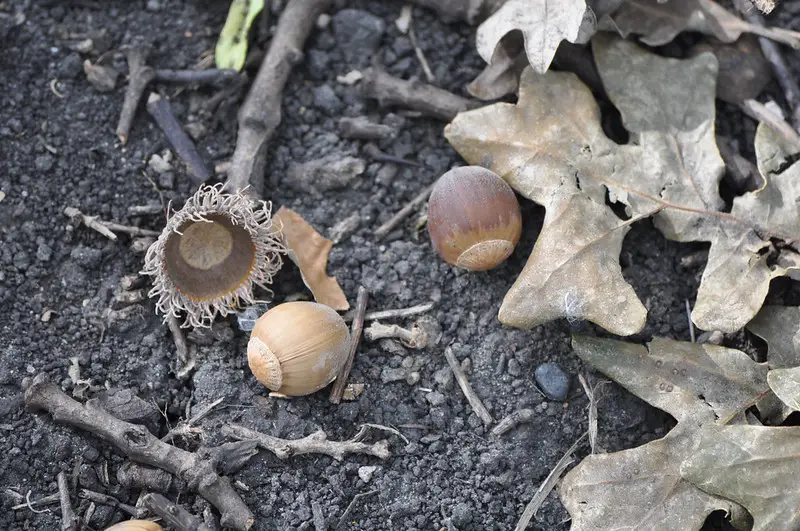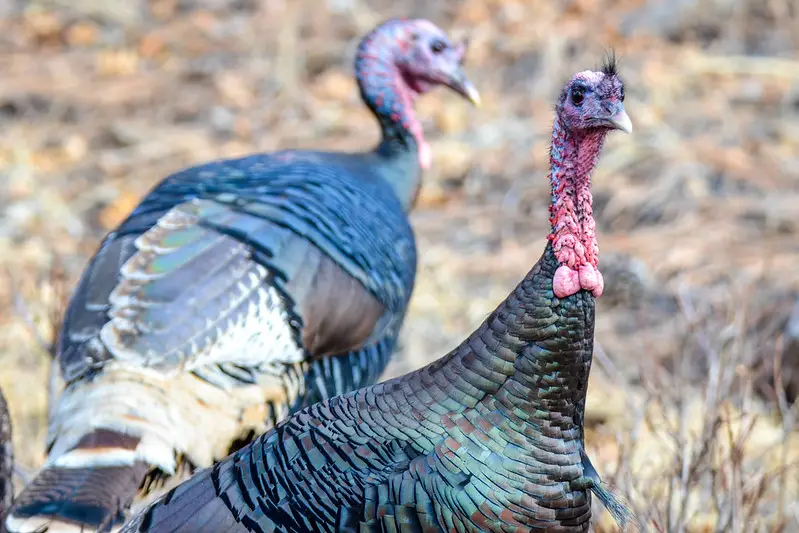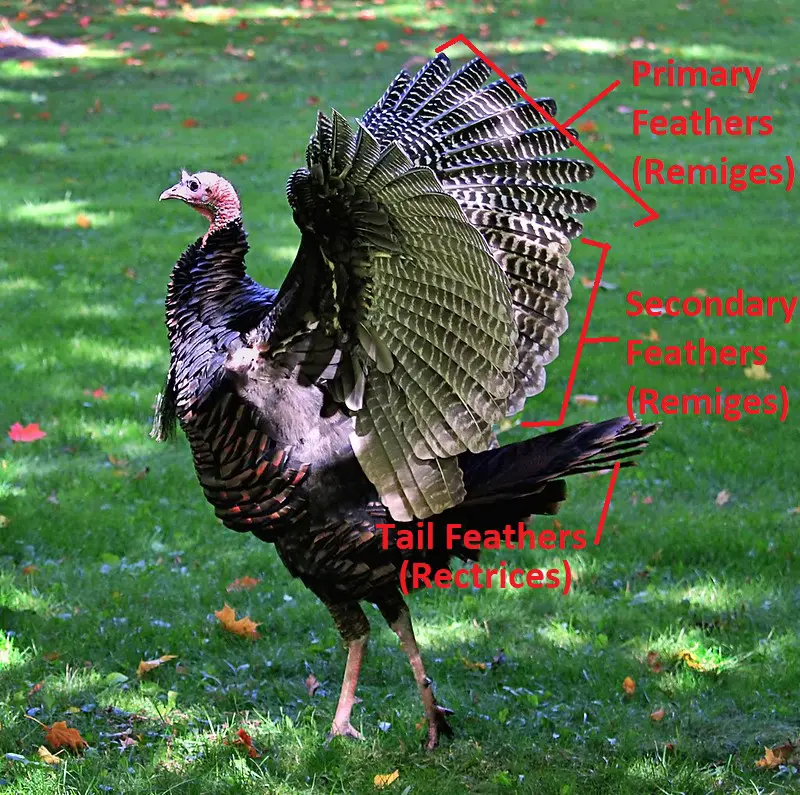
One of the coolest things about turkeys are their feathers. Feathers make each turkey unique. Their distinguishing marks help differentiate the subspecies.
On top of that, turkey feathers serve many practical purposes as well. Without them, a turkey would not be able to fly. They keep the turkey warm and dry during harsh weather. They help toms attract hens to mate with during the spring.
In this article, I will go over the different types of turkey feathers, the activities turkeys go through to keep their feathers in peek condition, and what you can do with turkey feathers if you have some.
Types of Turkey Feathers
A mature turkey will have somewhere between 5,000 and 6,000 feathers in total. These feathers serve a wide variety of functions.
Here are the different types of feathers and their functions.
Turkey Tail Feathers
Turkeys have 18 tail feathers known as rectrices. Collectively, these turkey feathers are called the fan.
The turkey’s tail feathers (along with the wing feathers) are overlapped by a series of feathers known as the coverts. These feathers help keep the turkey aerodynamic. They also provide insulation.
One function of the tail feathers is to aid the turkey in flying. They help provide stability and landing control.
Tom turkeys also use their fans to attract hens and intimidate rivals. Toms will “strut” by fluffing all their feathers out which makes them appear much larger. They will spread out their tail feathers as well.
Hunters have taken advantage of the turkey’s aggression by hiding behind turkey fans (real or synthetic) to crawl closer to toms. Many times the target toms will close the distance by charging at the fan and hunter. This tactic is known as reaping or fanning.
You can distinguish a jake (first-year male turkey) from a tom (mature male turkey) by his tail feathers. In a jake, the middle feathers on the fan will be longer than the outer feathers on either side.
The fan is also useful for distinguishing between subspecies. The tips of the tail feathers of a Merriam’s turkey are nearly white. These feather tips are more tan or buff in color on a Rio Grande turkey. On Easterns and Osceolas, the tips are a chestnut brown.
Wing Feathers
Turkeys have different sets of feathers on their wings. These flight feathers are known as remiges.
The outermost flight feathers (closest to the tip of the wings) are the primary feathers. Each wing has ten primary feathers. Without these feathers, the turkey can not fly.
The primary feathers are the easiest way to distinguish an Osceola turkey from an Eastern. Osceola turkeys’ primary feathers will be much darker with smaller white bars than the Eastern subspecies which tends to have more white barring.
The next set of flight feathers is known as the secondary feathers. These feathers are shorter than the primary feathers. Turkeys have 18 or 19 secondary feathers per wing.
Like the tail feathers, the wing feathers are also overlapped by coverts.
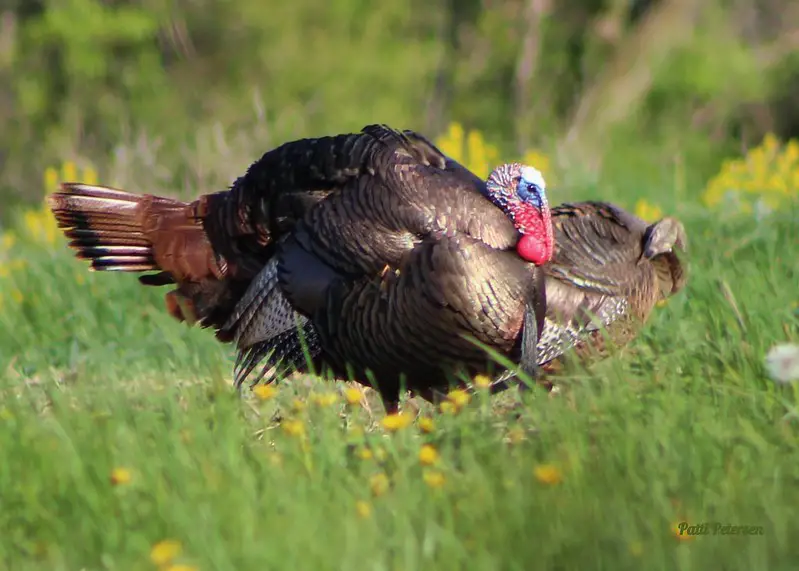
Contour Feathers
The contour feathers are the turkey’s protection against the elements. They shed water and keep the turkey warm.
They also provide most of the coloring you see on the turkey. On a hen, these contour feathers will have a brownish tip on them. The tom will have a darker, black tip to its contour feathers.
Each feather is controlled by a muscle allowing them to fluff or lay back their feathers as necessary. These muscles are also responsible for the “strutting” of the tom turkey when he fluffs out all his feathers.
How Turkeys Care for Their Feathers
Just as you and I wash our hair and skin, turkeys must maintain their feathers. They do this by dusting, sunning, and preening.
- Dusting- During this process, turkeys will completely cover themselves in dust. This helps remove old oils from their feathers. It also smothers parasites that may bother the turkey.
- Sunning- Turkeys will lie down, crouch, or otherwise position their bodies to get sunlight to their feathers. They use this process to dry out feathers, kill bacteria and parasites, and make the oils from the preen gland easier to manage.
- Preening- Like most birds, turkeys preen their feathers. They have a gland near their tail that produces oil. They will spread this oil over their feathers to moisturize and waterproof them. This process also helps keep the contour feathers in order.
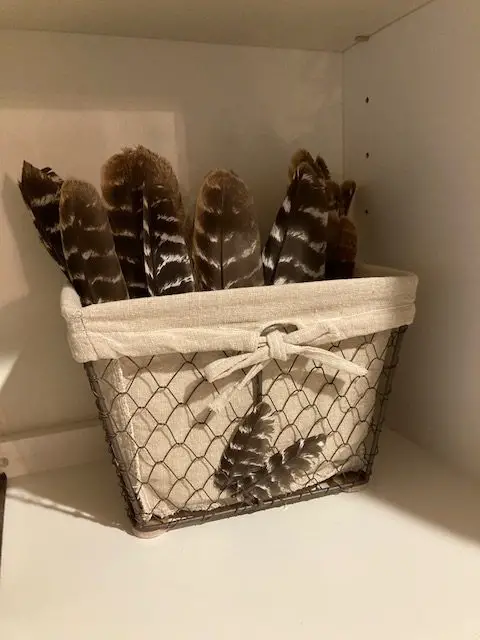
What To Do With Your Turkey Feathers?
Let’s say you’ve harvested a turkey this spring or fall, but you’re not going to mount the whole turkey. Is there anything you can do with these turkey feathers?
Absolutely. Here are a few ideas for you.
Fan Displays
Fan displays are a great way to show off your harvest. Unlike full-body mounts, fan mounts don’t take up a lot of room. You can hang them on the wall or do a nice tabletop display.
A taxidermist can certainly create a fan mount for you, but you can also buy a kit online. Grab a thing of Borax from the grocery store and assemble it yourself.
If you want to display even more of your feathers, consider mounting the entire cape and wings. You can find instructions for that here.
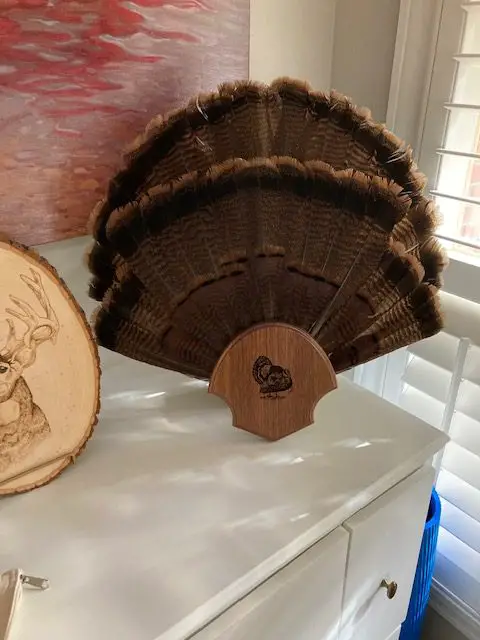
Home Decor
Turkey feathers can help add a sportsman’s touch to your home decor. Give your house a fall theme as the weather starts to cool with some feathers.
Add a basket full of turkey feathers to the mantle or a shelf. Drop a wild turkey feather or two in the centerpiece on your dining room table. Frame a feather for a beautiful wall decoration. Stick a few in a floral arrangement for extra texture.
There are many things you can do with feathers to accent your home. If you’re a creative person, you will have no trouble coming up with even better ideas than the ones above.
Cat Toys
If you have a feline friend, keep him entertained with a turkey feather toy. Tie a string to the end of a stick. Tie the other end to the turkey feather. Tease your cat by whipping the feather around the house just in front of his nose.
Alternatively, you can tape feathers to a small ball. Most cats will spend hours batting the feather ball all over the place.
Arrow Fletchings
If you’re a traditional archery hunter, you can try to make your own arrow fletchings out of turkey feathers. The Native Americans used wild turkey feathers (along with many other types of feathers) to keep their arrows flying straight.
The primary wing feathers make the best fletchings, but you can also use the secondary wing feathers. Check out this Youtube video to see how easy creating your own fletchings can be.
Flys
Do you enjoy fly fishing when you’re not turkey hunting? Why not try to make some flies with your leftover turkey feathers?
You can use tail feathers, feathers from the underside of the fan, leg feathers, and wing feathers to make different types of flies. For more details, read this article from Tenkara Angler about tying flies with wild turkey feathers.
Accents on Clothing, Jewelry, and Crafts
In addition to decorating your home, you can also use your turkey feathers to decorate accessories.
A turkey feather tucked into the band on your straw hat makes for a distinguished look. You could tie a few feathers to the top of a hiking staff for some added character. Incorporating turkey feathers into earrings or necklaces can make unique and beautiful jewelry.

